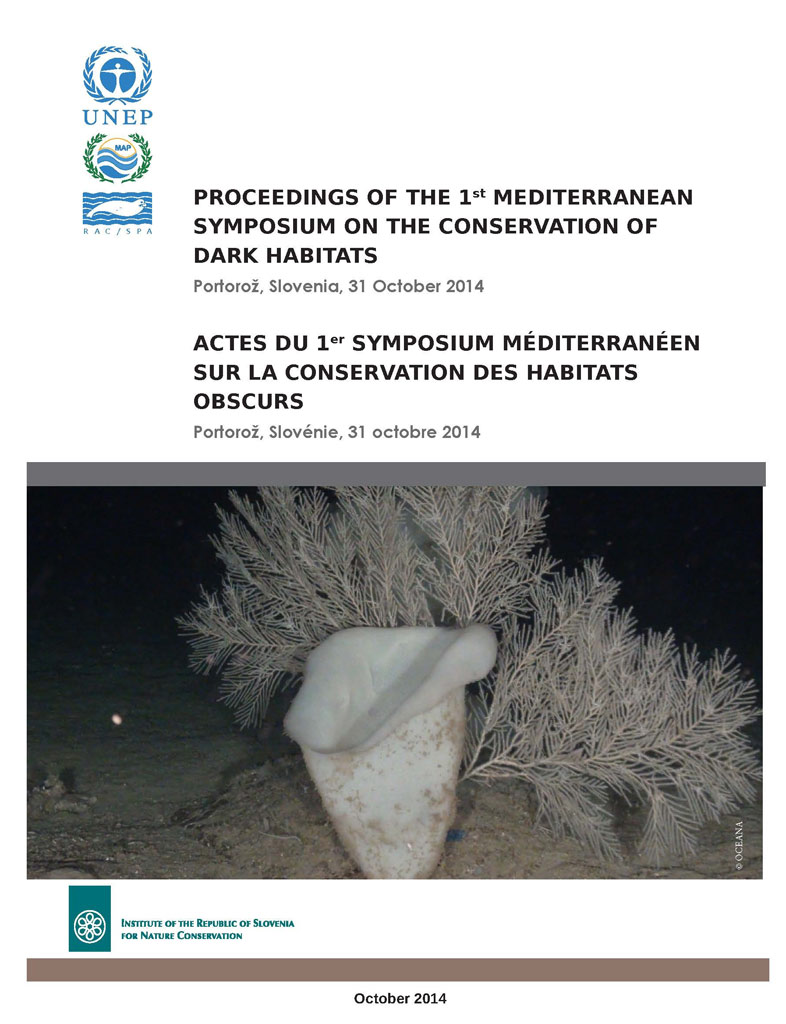Search
Action Plan for the conservation of habitats and species associated with seamounts, underwater caves and canyons, aphotic hard beds and chemo-synthetic phenomena in the Mediterranean Sea (Dark Habitats Action Plan)
Dark habitats are environments where the luminosity is extremely weak, or even absent (aphotic area) leading to an absence of macroscopic autochthonous photosynthesis.
The bathymetric extension of this lightless area depends to a great extent on the turbidity of the water and corresponds to benthic and pelagic habitats starting from the deep circa-littoral. Caves which show environmental conditions that favour the installation on of organisms characteristic of dark habitats, are also taken into account.
Dark habitats are dependent on very diverse geomorphological structures (e.g. underwater caves, canyons, slopes, isolated rocks, abyssal plains, cold seeps, brine anoxic lakes, hydrothermal springs and seamounts).
Dark habitats represent outstanding and potential ecosystems with regard to their:
- Frailty and vulnerability to any land-based pressure
- Play an important part in the way the Mediterranean ecosystem functions, insofar as they constitute the main route for transferring matter between the coast and the deep sea
- Considered as biodiversity hotspots and recruiting areas forming a veritable reservoirs of knowledge and biodiversity
- Natural habitats that come under Habitat Directive on the conservation of natural habitats and of wild fauna and flora and appear as such as priority habitats requiring protection (Directive 92/43).
- A certain number of underwater caves enjoy protection status because they fall within the geographical boundaries of Marine Protected Areas (MPAs)
Understanding of these functions is necessary for a better understanding and management of the biodiversity of Mediterranean coastal zones and continental shelf.
The Action Plan for the conservation of habitats and species associated with seamounts, underwater caves and canyons, aphotic hard beds and chemo-synthetic phenomena in the Mediterranean Sea was adopted in the Eighteenth Ordinary Meeting of the Contracting Parties to the Convention for the Protection of the Marine Environment and the Coastal Region of the Mediterranean and its Protocols (Istanbul- Turkey, 3-6 December 2013).
The objectives of the Action Plan are to:
- Conserve the habitats‟ integrity, functionality (favourable state of conservation) by maintaining the main ecosystem services and their interest in terms of biodiversity through the establishment firstly of legislative measures, setting up MPAs in secondly and foremost the application and development of regulatory procedures to restrict or prohibit some human activities if they exist.
- Conserve the habitats’ integrity, functionality (favourable state of conservation) by maintaining the main ecosystem services and their interest in terms of biodiversity
- Encourage the natural restoration of degraded habitats via reduction of human origin impacts
- Improve knowledge about dark populations (e.g. location, specific richness, functioning, typology) through national and regional data and scientific work in accordance with the objective of establishing a summary of knowledge of dark populations and their distribution around the Mediterranean in the form of a geo-referenced information system
To achieve these goals, public awareness through information and education programs to raise awareness of the dark Habitats, their vulnerability and the importance of preservation and strengthening of national capacities remain indispensable to implement this action plan and develop an optimal strategy for managing these fragile habitats.
At national level, the Mediterranean countries are invited to:
- develop national plans for the conservation of dark habitats taking into account the specificities of the country or even the areas concerned,
- suggest appropriate legislative measures, particularly as regards impact studies for coastal development and to check the activities that can affect these populations,
- setting up and updating scientific databases means available
- education and awareness for the public, actors and decision-makers, and
- the conservation of dark populations that are significant for the marine environment in the Mediterranean
The first Mediterranean Symposium on the conservation of Dark Habitats was held in Portorož (Slovenia), 31 October 2014. This symposium drew attention on the necessity to improve knowledge on the dark populations and their distribution in the Mediterranean in order to establish international cooperation networks and to facilitate sharing the experiences between the different Mediterranean countries. During the different sessions, a great effort was made in order to collect existing information on the distribution of canyons, caves and escarpments, the connectivity between dark habitats populations, their biodiversity and their community's functioning. A particular attention was also given to the pressures on these different types of habitats and to the possibility of their impact evaluation.
Documentation for download:
- Dark Habitats Action Plan:
UNEP-MAP-RAC/SPA. 2015. Action Plan for the conservation of habitats and species associated with seamounts, underwater caves and canyons, aphotic hard beds and chemo-synthetic phenomena in the Mediterranean Sea. Dark Habitats Action Plan. Ed. RAC/SPA, Tunis: 17pp. Click here to access the PDF. - Proceedings of the 1st Mediterranean Symposium on the conservation of Dark Habitats (Portorož, Slovenia, 31 October 2014):
UNEP/MAP – RAC/SPA, 2014. Proceedings of the 1st Mediterranean Symposium on the conservation of Dark Habitats (Portorož, Slovenia, 31 October 2014). LANGAR H., BOUAFIF C., OUERGHI A., edits., RAC/SPA publ., Tunis: 84 p., ISBN 978-9938-9574-1-9. Click here to access the PDF.









Find Us On...